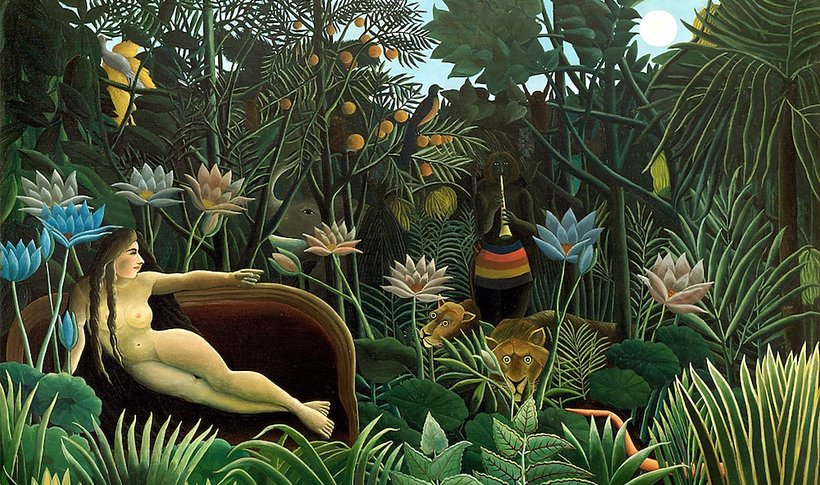Oil Painting: The Dream by Henri Rousseau
Henri Rousseau (1844-1910) was a French post-impressionist painter who carried primitive manner, and painted without going through the previously formal artistic education at the time. Although he was criticized many times in his lifetime, his work is now recognized to be among high quality paintings in popular museums such as the Museum of Modern Art. His paintings influenced many avant-garde artists much later on his career. Even though Rousseau is known to have never left the borders France, he has created more than 25 paintings carrying the theme of a jungle. He created these paintings based on the images of the “exotic,” as recognized by French colonialists. One of his most popular jungle based work is the oil on canvas painting: The Dream in 1910. Collecting inspirations from the Parisian zoos, Rousseau combines the “domestic” and the “exotic” in one painting, creating a surrealist atmosphere, much like a dream. By looking at The Dream, it is immediately evident that the originality of the painting indulges creative work of the unconscious mind. The work is beyond doubt surrealistic harmonized with primitivism which offers the viewer a more stimulating and encouraging way of interpretation, leading to curiosity which is an aspect of early 20th century modernism.
The Dream is a large 6’ 8 ½’’ by 9’ 9 ½’’ inches oil painting exhibited in the Museum of Modern Art in New York City. From first glance, it could be said that the painting has a distinct sense of symmetry. For example, the body of the female protagonist on the left is facing and pointing towards the right side of the canvas where a snake is seen to be facing her. The curved body of the snake suggests that it is also emphasizing the gesture of pointing towards the female. Regardless of this symmetry, the overall painting is composed of flattened space and plains of color, very smooth brush strokes –making the environment look soft, and distortions of scale, lighting and perspective. The exotic flowers, plants and trees are all very large compared to their size in real life and are vertically facing upwards indicating the sky and open space. The painting consists of a jungle scenery and a woman protagonist laying on a sofa as a strong contrast, letting the audience know that this is surreal. The protagonist is the first item noticed on the painting as she is the only character who does not belong in the exotic environment. She seems comfortable, determined and graceful as she is pointing her finger towards something, looking like she is giving an order. Her pose is comparable to Adam and God’s close touch depicted on the ceiling of the Sistine Chapel in Rome. She is a part of this dream-like state, and it almost seems as if it is made just for her. Surrounding her are animals from the jungle with bright contrasting colors as compared to the leaves: lions, elephants, snakes and birds. Taking a closer look however, a hidden native woman playing the flute can also be noticed –she is mysterious and a part of the jungle. Somehow, there is tension once the audience notices these aspects. It is as if the protagonist is ordering the animals a task and the flute playing in the background elevates the process of hypnose. The surrounding lively plants, fresh fruit, threat of animality, sight of hidden distances and full moon all sum up to the poetic nature of this painting.
Although The Dream is a surrealist piece, it reflects modernistic features. By inviting the viewer to explore the canvas visually, the audience is encouraged to open up to their curiosity and interpret and question endlessly. The radical idea that ties Rousseau’s painting to modernism it the significant fact that Rousseau never left France, therefore the “exotic” plants that he most likely saw in his garden were created purely out of his imagination and interest of the unknown, relating to Primitivism, adding on to the dream aspect of his paintings.

